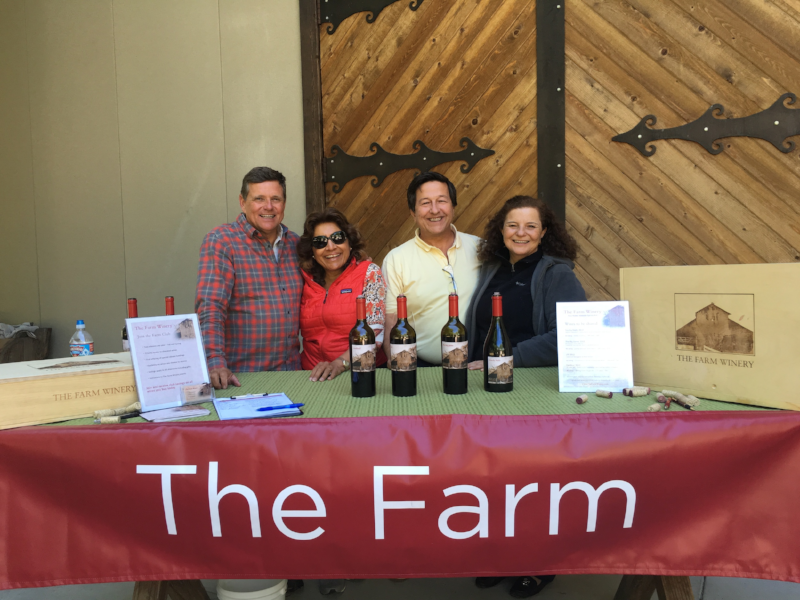The Farm: A Touch of Stanford, Paso Robles and Argentina
/The Farm: A Touch of Stanford, Paso Robles and Argentina
Nestled in the hills of Paso Robles Adelaida District American Viticultural Area (AVA) is a vineyard created by Business School buddies, established with a definite vision and with a special vibe to their full-bodied red wines. They may not be the biggest or the best-known wineries, but once you've had the opportunity to meet The Farm’s Jim and Azmina Madsen and have a taste of their “Touchy-Feely,” “The Big Game” or “Cardinal” wines, you are hooked.
We fortuitously tripped over Jim and Azmina at the Paso Robles Reserve Tasting event in May (they were sharing a table with one of our favorite wineries, Victor Hugo), and immediately liked Azmina’s outgoing personality. They were pouring their “Touchy-Feely” 81% Grenache/19% Syrah blend, along with their “The Big Game,” a 50% Cabernet, 38% Syrah and 12% Petit Verdot—a Rhône meets Bordeaux-style of brave, bold wine. Our simple notes from that day in regard to these wines: Touchy-Feely: Everything you want and expect from a Grenache blend. The Big Game: It’s a party in your mouth.
During our conversation we learned that The Farm’s winemaker was a fellow named Santiago Achaval, and that he was on his way from Argentina to Paso Robles. We were intrigued and hooked, especially after we Googled Santiago! He is one of the foremost makers of quality Malbecs in the world, and regular readers will know how we feel about Malbec! We had to meet this guy!
The Farm does not have its own tasting room, but we were fortunate in that they were having a guest pouring at Thacher Winery the next day. “And of course you can talk to Santiago,” Azmina promised.
So what do you do when interviewing a legend such as Santiago? You learn all you can before you actually meet him! He’s the founder of Achaval-Ferrer Winery in Mendoza, Argentina. The decision was made to learn all we could about Malbec, and what makes Achaval-Ferrer’s the best Malbec on Earth. Even more exciting, Santiago has founded Matervini winery in Mendoza to explore the most extreme vineyards in Argentina.
At the Thacher Winery tasting, Jim and Azmina were pouring Touchy-Feely, The Big Game (and we were happy to taste these again!) and their signature Cabernet, “Cardinal.” Azmina introduced us to Santiago and his very sweet wife, Mercedes, who shares in the passion of winemaking. Rather than focus on the wines before us, we decided to ask the question you all want to ask: “What is the difference between growing Malbec grapes in Paso Robles versus Mendoza, Argentina?”
By now you have seen us use the term terroir—the environmental factors including soil type, weather, geography and even other plants growing nearby. Every winemaker is working to preserve and enhance terroir, and sommeliers with finely tuned taste buds can identify where a wine was grown based upon taste and appearance. Remember this statement—it applies to one of the wines we tasted!
There are significant differences in terroir between Mendoza and the Paso Adelaida District. The soils in western Paso Robles are limestone and sedimentary in nature, with flat and gently rolling hillsides. In Mendoza, the soils are alluvial (glacial), drain well and vineyards are grown on a 2-3% grade. The day-night temperature swings are also widely different—Mendoza is not subject to the ocean influence as are Central Coast vineyards. It’s easy for the coastal fog to climb our relatively low 3,000 feet in elevation coastal mountains versus the Andes, which top out to 22,000 feet, making it impossible for the nighttime cooling fogs to reach the vineyards. That oceanic influence in Central Coastal California results in a bit of a haze as far as sunlight is concerned, versus Mendoza’s unfiltered light that does not have to penetrate a low cloud cover.
Argentina’s Malbec differs from Malbec grown everywhere else on Earth because it was not subject to the devastating phylloxera outbreak in the late 19th century that wiped out vineyards in France and North America. The grape had been introduced to Argentina in 1852 and thrived, and while it’s grown in several Argentinian regions, most (85% of Argentina’s Malbec) are grown in Mendoza.
Truly great Malbec and its concentrated, bold flavors, are acquired by careful viticulture. Unlike row crops, winemakers often want low yields. That is accomplished by removing fruit from the vine in order to ensure a yield of 1 ton of grapes per acre. In some vineyards in Argentina, vines are grown close together to keep yield down, but if necessary, fruit is also manually removed. With less fruit on the vine, the plant can concentrate on developing the flavors in the grapes and creating that unique terroir.
Another technique Santiago uses is to remove much of the leaf cover from the fruit zone of the grapevines as soon as the fruit sets. Removing the leaves from the side of the vine that gets the morning sun allows the grapes themselves to get used to the sunshine, and the tannins develop naturally on the vine. He compared this process to that of getting a suntan: if you expose your skin to sunshine for a short time every day, you skin will adapt and tan. But it you have a day of long, intense exposure, you’ll get a sunburn. The Malbec grapes adapt to that extra sunshine.
Santiago lets the grapes themselves decide when it’s time to pick. He’s looking for that perfect blend of peak ripeness and flavor development, which usually happens about 24-1/2 brix , a measurement of sugar content. Santiago will personally roam the block of grapes, tasting fruit from the vine to help him decide when to pick. In Malbec grapes, he does not wish for the grapes to be picked while unripe or green, which negatively affects the wine. Even the seeds within the Malbec grapes themselves are ripe at harvest, though he cautions that seed color/ripeness isn’t always an accurate sign of ripeness—Grenache grape seeds are always green.
At harvest, Santiago has the grapes cleaned in the field, with leaves and bad grapes left behind. Before the grapes are transported, he inoculates the newly-picked grapes with yeast to help fermentation start. During the sometimes 36-hour drive from the vineyard to the winery, the movement of the grapes and the yeast combine. There will be a second sort of the grapes at the winery, and then it’s off to be pressed and ultimately end up in barrels for aging. Santiago’s Malbecs are a perfect library wine, with aging potential for some of his wines being 10 to 20 years!
Many of Santiago’s techniques are applied on grapes grown by The Farm Winery. Jim and Azmina are very hands-on and they wander their vineyards always thinking “What’s best for the grapes?” Their wines are a combination of the best of Rhone and Bordeaux-styles.
On this day we savored each glass of wine, and enjoyed Santiago’s narrative.
Touchy-Feely is the best of Grenache grapes, a Rhône-style wine with a bit of Syrah to enhance and play with Granache’s natural tendencies to be spicy with berry flavors. The Syrah adds a fruitiness or jaminess. There’s a bit of mineralness on the palate—a good thing. This is a nice, spicy wine that will keep in your wine collection for at least five years and will be happy served with a story dish of pork, lamb or venison.
The Big Game’s name is a play on words, referring to the Stanford alumns’ loyalty to their alma mater and any athletic contest against the University of California, Berkeley, which is located across the San Francisco Bay. The Game also refers to the interplay between the two styles of wines—Rhône and Bordeaux. It’s truly a party in your mouth and on your nose. It’s a bolder wine than Touchy-Feely, with black stone fruits, pencil shavings (the proper term is “graphite”) and lavender. This wine, like Touchy-Feely, can hang around in your wine collection for 10 years or so and is the perfect wine to accompany a nice fatty cut of meat—a rib eye steak or pork ribs.
Finally Santiago brought out Cardinal, a 100% honest-to-goodness Cabernet Sauvignon. The vines these grapes come from are among the oldest Cab vines in Paso Robles—over 50 years old. Both Jim and Santiago remarked that these grapes tell you exactly where they are from: the Old Bailey Vineyard on Peachy Canyon Road. Those grapes and the resulting wine are perfect examples of what terroir is—they taste like the southern Santa Lucia mountains, with granite and limestone chalk rock, morning fog, oak trees and native grasses. Plum, cherry, blackberry, dried fig and tobacco along with the qualities from the terroir make this wine a special one—unlike most Cabernet Sauvignons, you’d not want to waste this wine on a simple roasted cut of red meat! Think a duck carpaccio, BBQ spicy-sweet lamb or even braised red cabbage.
For one of our tasters, Cardinal evoked specific memories of working in vineyards in the Santa Lucia Highlands in the mid-1970s, with the smell of the moist vines and grapes, some nearby oak trees and dry grass cattle pastures, the fog-dampened soil and the promise of a warm day with windy afternoons.
The Farm Winery’s wine club consists of two releases per year, in the fall and in the spring. With membership you get priority access to allocated wines, the ability to choose the wines you want to receive, and first offering of special release bottles. There are three levels of membership, starting with the “Join 3” consisting of three bottles per release at $165-205 per shipment, the “Join 6” where you can choose your selections, receive six bottles at a cost of $305-360, and finally the “Join 12” of 12 bottles per release at a cost of $625-720.
The Farm Winery is located on Chimney Rock Road in Paso Robles and tastings are by appointment at 15C in Templeton. 15C’s phone is 805-434-1554. Their wines are positively sublime and if you like full-bodied red wines that can be enjoyed on their own or alongside your favorite meal, this is the place for you.
A big thank you to Jim from the Farm Winery for the use of photos, which can be found on their Instagram page.
















